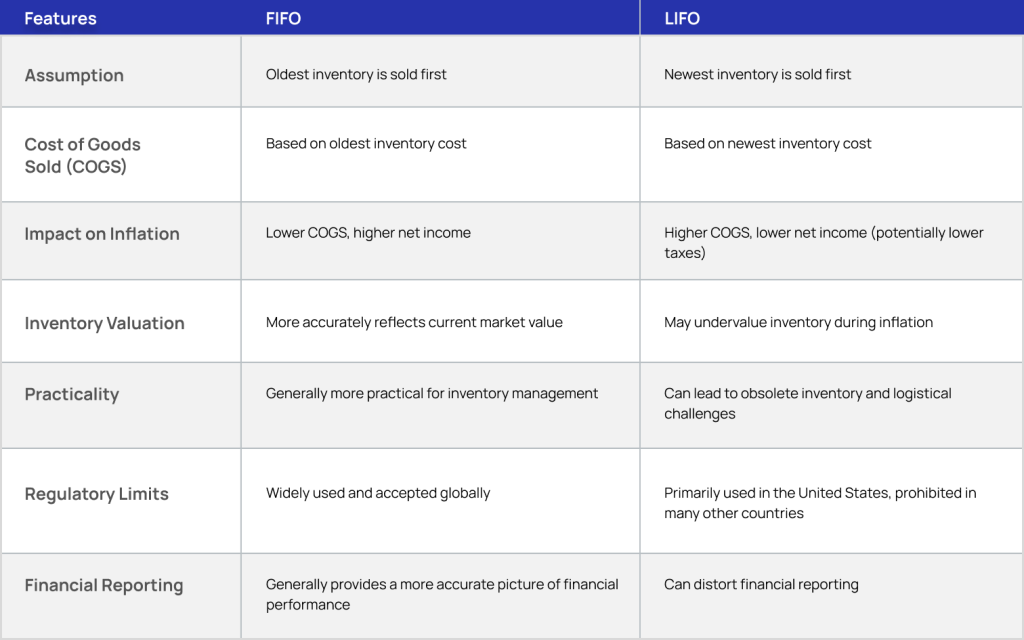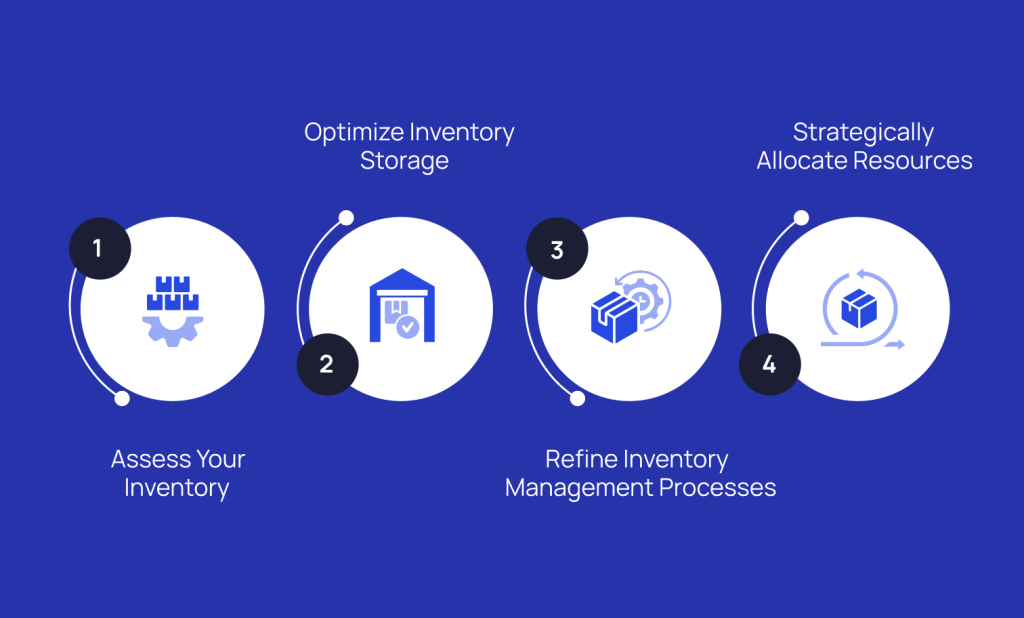FIFO Method (First In, First Out): Meaning, Benefits, and How It Works
Blogs
Inventory management is a critical success factor in today’s hyper-competitive retail scene, as it helps in determining profitability and customer satisfaction. Inventory distortion due to stockouts and overstocks was projected to cost retailers a whopping $1.7 trillion in 2024, according to the IHL Group. To minimize the risks of inventory inaccuracies, maintaining optimal inventory levels is key. Too much stock drains resources and increases the risk of obsolescence, while too little can lead to lost sales and frustrated customers.
To navigate these complexities, businesses need a robust system for tracking and valuing inventory. One such system is FIFO, a strategic approach to optimize inventory flow and ensure financial accuracy. In this article, we’ll delve into the importance of FIFO in inventory management, how it contrasts with LIFO, the pros and cons that come with FIFO, and practical steps to implement this method in an accurate and efficient manner.
What is FIFO?
FIFO, which stands for First-In, First-Out, is a fundamental accounting and inventory management method. This method assumes that the oldest acquired goods are the first ones sold, making it crucial for businesses dealing with perishable goods, seasonal products, or raw materials. FIFO primarily dictates how the cost of goods sold is calculated. Even if sales don’t exactly mirror the “first-in, first-out” sequence, this valuation method assigns the cost of the oldest inventory to the earliest sales. For a warehouse operating under FIFO, the first items that enter the warehouse are strategically positioned for immediate sale. This consistent rotation ensures that inventory doesn’t linger, minimizing storage time and the risk of expired or outdated products.
Why is FIFO Important?
Having an effective inventory management strategy is paramount for any business — FIFO plays a critical role in this process. By prioritizing the sale of older stock, businesses minimize the risk of holding onto outdated or expired products. This not only preserves product quality and integrity but also ensures customer satisfaction with fresh and reliable goods.
Furthermore, FIFO contributes directly to profitability. By utilizing lower-cost older inventory for cost of goods sold calculations, businesses can optimize their profit margins. This is especially beneficial in periods of rising costs, allowing businesses to maintain competitive pricing while safeguarding their bottom line.
How Does the FIFO Method Work?
FIFO, in the context of inventory management, dictates that the oldest acquired goods are sold first. This principle ensures a continuous flow of inventory, minimizing the risk of holding onto outdated or expired products. While the formula for calculating Cost of Goods Sold (COGS) remains consistent (COGS = Starting Inventory + Purchases – Ending Inventory), the main distinction with FIFO lies in the order of inventory consumption. It assumes that all units acquired first are sold before any units from subsequent purchases.
Let’s consider a simple example: a bakery. Say this bakery buys flour. They purchase a batch in January, and then another batch in March, but this time the price is higher. Even though they might mix the flour together, the bakery uses the FIFO method for accounting. This means they assume the bread they sell was made with the older, cheaper flour first. This impacts how they calculate the cost of making the bread (COGS) and the value of the remaining flour in their inventory.
FIFO vs. LIFO: Key Differences
While FIFO assumes the oldest inventory is sold first, LIFO operates under the opposite principle, assuming the most recently acquired goods are sold first. Here’s a brief overview of what sets these two methods apart:

As seen in the table, FIFO aligns more closely with actual inventory flow. This prioritization of older items minimizes the risk of spoilage or obsolescence, which is especially crucial for businesses with perishable goods. LIFO, however, can lead to a buildup of older, potentially outdated stock in the warehouse. This approach can result in wasted resources and increased holding costs. Accurately tracking inventory becomes more complex under LIFO, potentially leading to inefficiencies in order fulfillment and increased risk of stockouts or overstocking.
Benefits of the FIFO Method
FIFO, a globally preferred method of inventory management, offers the following advantages:
- Easy Implementation: Its straightforward logic and ease of implementation make it accessible to businesses of all sizes.
- Accurate Reporting of Inventory Value: As FIFO aligns with the natural flow of goods, it’s able to provide a more accurate picture of ending inventory value, reflecting current market conditions.
- Higher Gross Income: By assigning the cost of older (typically lower-cost) inventory to the cost of goods sold, FIFO generally results in higher reported gross income.
- Enhanced Operational Efficiency: By adhering to FIFO principles, businesses can streamline inventory management with accurate inventory data, resulting in speedy order fulfillment.
- Saves Costs & Improves Cash Flow: Optimizing inventory turnover by minimizing idle time reduces holding costs and the risk of obsolescence. This translates to quicker revenue generation and improved cash flow.
- Better Customer Experiences: This approach ensures customers consistently receive fresh and high-quality products, enhancing customer satisfaction.
- Improved Financial Reporting: By accurately assessing the value of remaining inventory based on the FIFO assumption, businesses gain a clearer picture for financial reporting for better and informed decision-making.
Challenges of the FIFO Method
While FIFO offers several advantages, it also presents certain challenges.
- Complex Maintenance: Maintaining accurate FIFO records can be complex, especially for businesses with large and diverse inventories.
- Overstated Profits in Inflation: In inflationary periods, FIFO can overstate profits by assigning lower costs (from older purchases) to goods sold, potentially leading to higher tax liabilities.
- Misaligned with Actual Inventory Flow: In industries with rapid innovation or evolving product life cycles, the actual flow of inventory might not always align with the FIFO assumption. This can distort the true cost of goods sold.
- Limited Relevance in Declining Markets: FIFO can undervalue inventory in deflationary periods, potentially distorting financial statements and making it difficult to accurately assess the company’s true financial health.
Real-World Examples of FIFO in Different Industries
The principles of FIFO can be applied across diverse markets. From the milk aisle to the pharmacy to the smartphone you use, FIFO is a fundamental best practice wherever product freshness, rapid obsolescence, or strict quality control is a concern.
- Grocery and food retail: Supermarkets rigidly apply FIFO to perishable items like dairy, meat, and produce. When new stock arrives, employees place it behind the older stock, ensuring the consumer always buys the item with the nearest expiration date. This prevents spoilage, minimizing shrinkage (product loss), and safeguarding public health.
- Fashion and apparel: In this industry, “perishability” is defined by fashion trends and seasonality, not expiration dates. A summer dress purchased in January must be sold before newer, on-trend stock arrives in June. Using FIFO ensures that older inventory is discounted and moved out promptly, preventing the accumulation of obsolete styles that tie up capital.
- Electronics and technology: For products like smartphones, laptops, or even components, FIFO is crucial because of rapid obsolescence. The older generation of a microchip (the first-in stock) must be costed and sold quickly before the newer, faster, and often cheaper-to-produce model (the later-in stock) hits the market, thereby protecting margins on the outgoing product.
- Pharmaceuticals and medical supplies: This sector requires the strictest adherence to FIFO for safety and regulatory compliance. Every drug has a shelf life, and selling newer stock before older stock could lead to expired, ineffective medication reaching patients. Inventory systems must be robust enough to track batch numbers and guarantee FIFO flow.
How FIFO Influences Inventory Turnover and Cash Flow
By dictating the movement of goods, the FIFO method helps maintain healthy inventory turnover and directly optimizes your business’s financial speed, or cash flow cycle. Let’s look at this in more detail below:
1. Boosts Inventory Turnover
FIFO inherently drives inventory movement. By establishing the firm rule that the oldest stock must be sold first, you are compelled to organize your warehouses and picking processes to facilitate this flow. This disciplined approach means products spend less time sitting on shelves, which directly increases the inventory turnover rate.
2. Reduces Holding Costs
High turnover, fueled by FIFO, minimizes the time inventory is held. Less time held means lower associated holding costs, including storage rent, insurance, utility bills, and labor required to maintain the stock. Preventing obsolescence and spoilage further reduces write-offs, preserving capital.
3. Improves Cash Flow Cycle
When inventory moves faster, it is converted into revenue more quickly. For example, if a retailer buys a product in January and sells it in February (following FIFO), that cash is recovered and reinvested far sooner than if the same product sat until May. This acceleration of the cash-to-cash cycle allows the business to reinvest capital sooner, funding new purchases and sustaining operations with greater agility.
4. Supports Accurate Pricing Decisions
In an inflationary environment, FIFO’s assumption of lower COGS results in a higher reported gross profit. While this can have tax implications, it provides management with a clearer picture of their operational markup based on current replacement costs, helping them set more competitive future prices.
Best Practices for Effective FIFO Management
To realize the full benefits of FIFO, businesses must move from theory to action. This means implementing practical, real-world strategies that ensure your physical inventory flow matches the financial records. The best practices to follow are:
1. Establishing a Strict Warehouse Organization
Implement a layout where products are stored based on their receipt date. Use shelving and racking systems that physically enforce flow, such as flow racks or drive-through pallet racks, where loading is done from the back and picking is done from the front.
2. Implementing Date-Based Labeling
Every incoming product carton or pallet must be immediately tagged with the date of receipt or a clear batch number corresponding to the purchase order. This visible labeling makes it impossible for warehouse staff to mistake older stock for newer stock during the picking process.
3. Investing in Integrated Technology
Utilize unified solutions like a robust inventory management system that can automatically calculate COGS using the FIFO principle and generate pick lists that explicitly prioritize the oldest items first, eliminating human error in manual selection.
4. Continuously Training Staff and Conducting Audits
Regularly train all warehouse and fulfillment staff on the critical importance of the FIFO rule. Conduct frequent cycle counting and spot audits to check inventory dates and ensure that the physical stock movement aligns perfectly with the FIFO assumptions recorded in the system.
How to Implement the FIFO Method
To effectively implement FIFO, businesses must tailor their approach to their specific needs. This involves considering factors like inventory type, perishability, and demand, all while optimizing storage space, manpower, and handling processes to minimize costs and maximize returns.
Here are key action steps businesses can take to implement the FIFO method:
- Assess Your Inventory
Start off by classifying your inventory. this means differentiating between fast-moving, slow-moving, and seasonal items. By doing so, you’re able to tailor storage and rotation strategies. Prioritize FIFO for items with limited shelf lives, such as food, pharmaceuticals, certain electronics, and other perishable goods.
- Optimize Inventory Storage
Store items strategically for quicker retrieval and sale; consider the “milk carton” method where older inventory is placed at the forefront in easily accessible locations. To facilitate efficient stock rotation, create dedicated storage zones for different inventory categories. Having a robust warehouse management system (WMS) will aid in accurately tracking inventory movement and generating real-time reports.
- Refine Inventory Management Processes
For the FIFO system to work as planned, it’s important to smooth out any kinks in your inventory management processes. Periodic physical inventory checks and regular stock rotations can ensure that older items are always sold first. It’s also important to train warehouse staff to practice “first-in, first-out” picking when fulfilling orders. To maintain consistency, conduct regular audits to verify adherence to FIFO principles and identify areas for improvement.
- Strategically Allocate Resources
Having adequate manpower in place is essential for efficient inventory management. Integrating automation has become a popular option for growing retailers to minimize handling time and reduce the risk of errors. Forbes also reports that automating warehouse operations with AI can lead to a significant increase in order fulfillment accuracy. In this case, an inventory management solution can offer the smart features needed to improve operational performance.
By carefully considering these factors and implementing a robust inventory management system, businesses can effectively leverage the FIFO method to optimize inventory turnover, reduce costs, and enhance overall profitability.

Future of FIFO with Technology and Automation
While the core of FIFO remains the same, its execution is entering a new era. Smart technology and automation are ensuring the “First-In, First-Out” rule is followed flawlessly, even in the largest, most complex supply chains. Here’s how:
- Smart automation and robotics: In large distribution centers, automated storage and retrieval systems (ASRS) and picking robots are programmed with FIFO logic. They physically retrieve the unit that has been in storage the longest, guaranteeing perfect compliance 24/7 without human intervention or error.
- AI-driven forecasting: Advanced AI systems use FIFO-based sales history to create more accurate demand forecasts for the near term. Knowing which specific batch or date-coded stock is next to be sold allows the system to optimize purchase orders, timing the arrival of new inventory precisely as the oldest stock is depleted.
- Blockchain to track product origin and movement: For high-value or highly regulated goods (like pharmaceuticals), blockchain technology is being explored to create a firm, shared ledger of every transaction and date from production to shelf. This system guarantees the true “first-in” date, ensuring maximum transparency and regulatory adherence for FIFO.
Conclusion
While not universally applicable, implementing a FIFO strategy is vital for most businesses to improve order fulfillment processes, minimize stock losses, and maximize the return on inventory investment. To effectively implement FIFO principles across your entire inventory ecosystem, Anchanto’s Inventory Management solution empowers e-commerce businesses with the necessary tools and insights to ensure accuracy, efficiency, and improved profitability.
Schedule a demo with our experts today to explore smarter inventory management and see these capabilities in action.
FAQs
1. Is FIFO suitable for all types of businesses?
FIFO is suitable for most businesses, but is especially beneficial for those dealing with perishable goods, products with short shelf lives, or items subject to rapid technological or fashion obsolescence.
2. How does FIFO impact profitability and taxes?
In times of inflation, FIFO results in a higher reported gross profit and therefore higher tax liability because the older, lower cost is assigned to the goods sold.
3. What tools or software can help automate FIFO?
Inventory management solutions, Warehouse Management Systems (WMS), and comprehensive Enterprise Resource Planning (ERP) platforms are essential tools that automatically calculate COGS and generate FIFO-compliant pick lists.
4. What is the biggest risk of using FIFO in volatile markets?
The biggest risk of using FIFO in volatile markets is that it can overstate current profits during periods of high inflation, which may lead management to make poor long-term financial decisions or face unexpectedly high tax obligations.
5. How does FIFO support food and perishable goods industries?
FIFO is critical in the food and perishable goods industries because it legally and practically ensures that the oldest products are sold before they expire, thereby maintaining product quality, minimizing waste, and ensuring consumer safety.
